Reducing greenhouse gas emissions through fossil fuel substitution
Projected to represent one-fifth of total energy supply in 2050, sustainable bioenergy is expected to continue playing a key role in decarbonising all energy sectors, and by extension, the global economy. Bioenergy replaces fossil fuels in energy production, thereby reducing GHGs. It is, however, crucial to source biomass from sustainably managed forests and agricultural lands, as well as to apply governance systems to ensure sustainable operations.

Sustainable forest management allows the biogenic carbon cycle to be leveraged to help decarbonise the economy and achieve the climate goals (Photo credit: Pixabay/Marcin Jozwiak)
The fossil-dominated energy sector is responsible for around three quarters of GHG emissions today and holds the key to averting the worst effects of climate change. In 1990, global energy-related CO2 emissions were estimated at 20.5 Gt, and reached 31.5 Gt in 2021. This contributed to CO2 reaching its highest-ever average annual concentration in the atmosphere of 412.5 parts per million in 2020— around 50% higher than at the start of the industrial revolution in the mid-1700s.
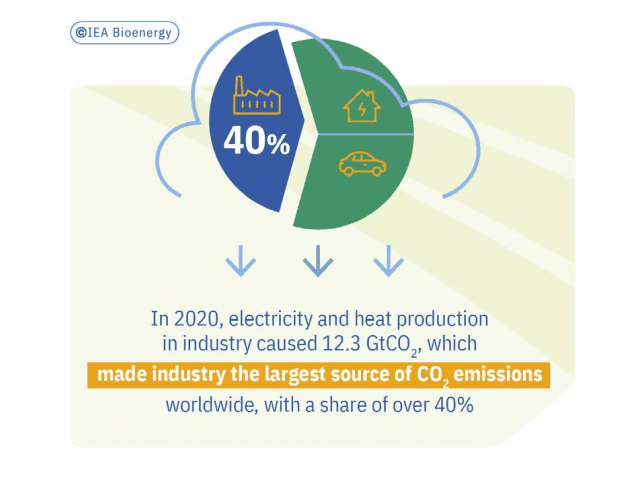
Bioenergy is the main source of renewable energy today, and its role in climate change mitigation should not be underestimated. The IEA Net Zero by 2050 Roadmap estimates that the supply of modern bioenergy needs to triple to achieve net zero energy-related CO2 emissions by 2050.
Today, bioenergy covers approximately 10% of the global overall energy demand and is the main source of renewable energy, with modern bioenergy accounting for 50% of global renewable energy consumption.
Bioenergy contributes to energy used in power generation, heat for industry and buildings, and transport fuels. Sustainable bioenergy can effectively reduce fossil fuel use in the short term, and can contribute to phasing out fossil fuels altogether. Furthermore, bioenergy is the only renewable energy source that can remove CO2 from the atmosphere, when combined with carbon capture and storage (CCS) (namely, bioenergy with carbon capture and storage [BECCS]).

In the field of electricity production and storage, biomass can be used for co-firing or in existing combined heat and power (CHP) plants. Moreover, as the contributions from solar and wind power increase, bioenergy can support grid stability by complementing other balancing options, such as battery storage and reservoir hydropower.
The electrification of the transport sector will require a substantial increase in electricity supply, including electricity produced by sustainable (and potentially even carbon-negative) bioenergy. In hard-to-abate transport sectors, such as aviation and shipping, liquid biofuels can be used to replace fossil fuels. When combined with CCS, negative emissions can be generated during the biofuel production process.
In the building sector, district heating systems in densely populated areas and small-scale combustion technologies in rural areas (boilers and stoves) can provide heating and domestic hot water supply. Biomass-based CHP plants can provide both heat and electricity supply.
In the industry sector, the main application of bioenergy is currently in biomass-processing industries that use their own residues to cover their energy demand (e.g., wood processing, pulp and paper). With industry being more and more motivated to reduce GHG emissions, biomass can increasingly be a substitute for fossil fuels in other sectors, as well as providing high-temperature process heat (e.g., steel production).
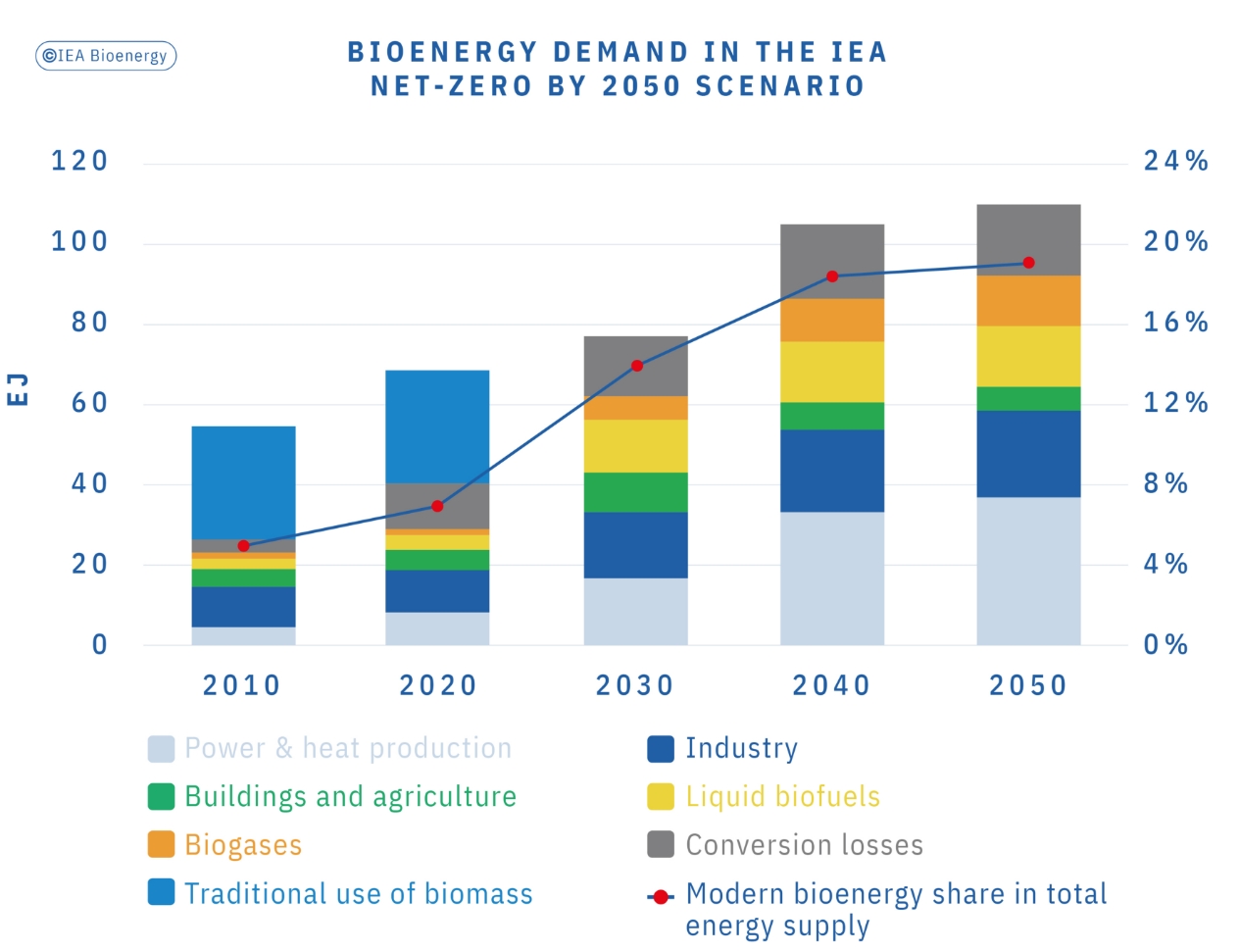
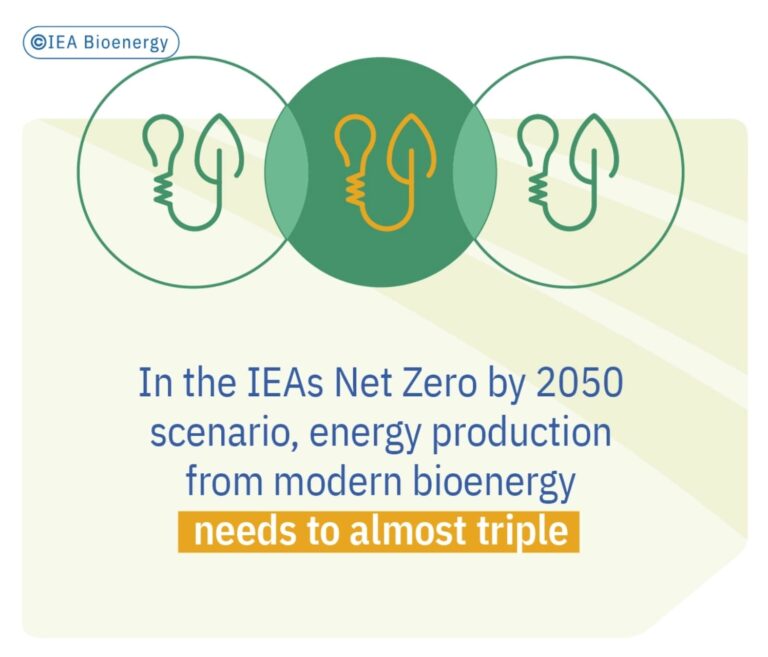
An increased use of bioenergy needs to be supported by an increase in available feedstock. The IEA Net Zero by 2050 Roadmap estimates that this will be possible thanks to an increased use of forest and wood residues as well as short-rotation woody and grassy crops. In addition, organic residues and waste streams will provide significant amounts of bioenergy (e.g., to replace the traditional use of biomass in developing countries).
As actual GHG emission savings need to be assured, it is important to assess GHG emissions of bioenergy systems at the landscape level across the full life-cycle. Discussions on the climate effects of forest bioenergy have recently involved particular controversy. To understand these, including the temporal and spatial system boundaries and reference scenarios used in the assessments, several factors need to be taken into account. A recent paper (“Applying a science- based systems perspective to dispel misconceptions about climate effects of forest bioenergy”) points out that forest bioenergy should not be assumed to be carbon-neutral by default—forests managed according to sustainable forest management principles and practices can contribute to climate change mitigation by replacing GHG-intensive materials and fossil fuels and by storing carbon in the forest and in long-lived forest products. Bioenergy systems operate within the biogenic carbon cycle. This implies a fundamentally different influence on atmospheric CO2 concentrations over time compared to fossil fuels; fossil fuel use transfers carbon out of the ground and into the atmosphere, causing a permanent increase in atmospheric CO2.
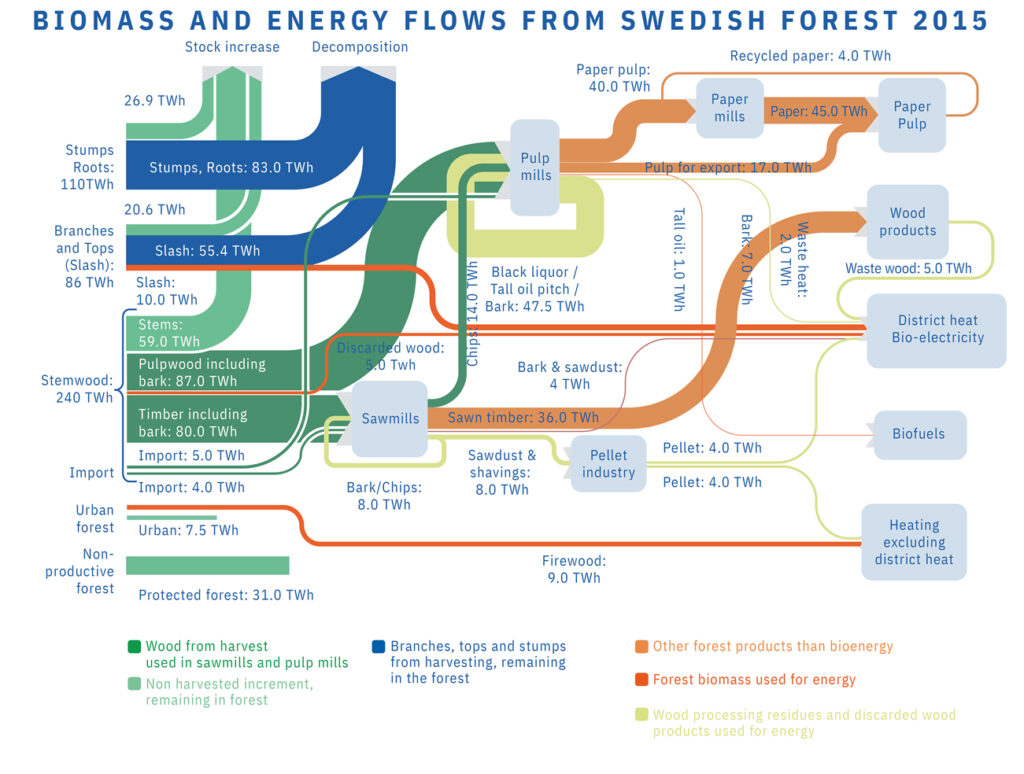
Bioenergy and forest carbon balance
A widely discussed topic related to bioenergy and its sustainability is that of “foregone carbon sequestration” resulting from use of forest biomass. The concept refers to a trade-off between the objectives of storing carbon in the forest and the harvesting of wood to produce forest products.
Forests managed for production of wood products, including bioenergy, may have lower carbon stocks than unharvested forests. This gap is sometimes referred to as foregone carbon sequestration. In the absence of forest management and harvest, however, forest growth rates decline and disturbance risks increase as trees become mature. While old and unharvested forests can thus hold large amounts of carbon per hectare, they also have a lower sink strength and may become carbon sources instead of sinks.
Sustainable harvesting of trees and the management of stem densities and species composition of the forest help maintain net forest growth (i.e., carbon sinks), allowing sustainable harvesting. The carbon stock at a regional or national level can, in fact, increase simultaneously with increases in harvesting. A recent study shows that, for example, in Sweden, and other boreal countries, under fairly intensive forest management, the standing volume of forests (hence, the carbon stock) and its rate of carbon sequestration has increased over the past decades, at the same time as annual harvest has increased.
Scientists from IEA bioenergy Task 45 have explained that sustainably managed long-rotation forests are not primarily harvested for bioenergy products, but produce bioenergy feedstock along with sawlog and pulpwood production for material applications; such applications can create substitutes for more carbon-intensive building materials such as concrete, steel, and aluminium. Residues from such forestry operations (including larger branches, damaged stem sections, and thinning material) and wood processing residues (including e.g., sawdust, bark, and black liquor) tend to be used for bioenergy. These biomass sources have a high likelihood of reducing net GHG emissions when they are substituted for fossil fuels; it is also widely accepted that their use for bioenergy enhances the climate change mitigation value of forests managed for wood production.
While forests, both managed and unmanaged, take up large quantities of carbon through photosynthesis, a major part of that carbon is emitted back to the atmosphere through decomposition or fires. If part of this material is used to provide an energy service, climate benefits are likely. Furthermore, extraction of lower quality biomass (e.g., resulting from pest and disease impacts or overstocking) that would otherwise be left in the forest to decompose, can reduce the frequency and severity of wildfires and the associated loss of forest carbon and release of non-CO2 GHGs; this further enhances the benefits to the climate.
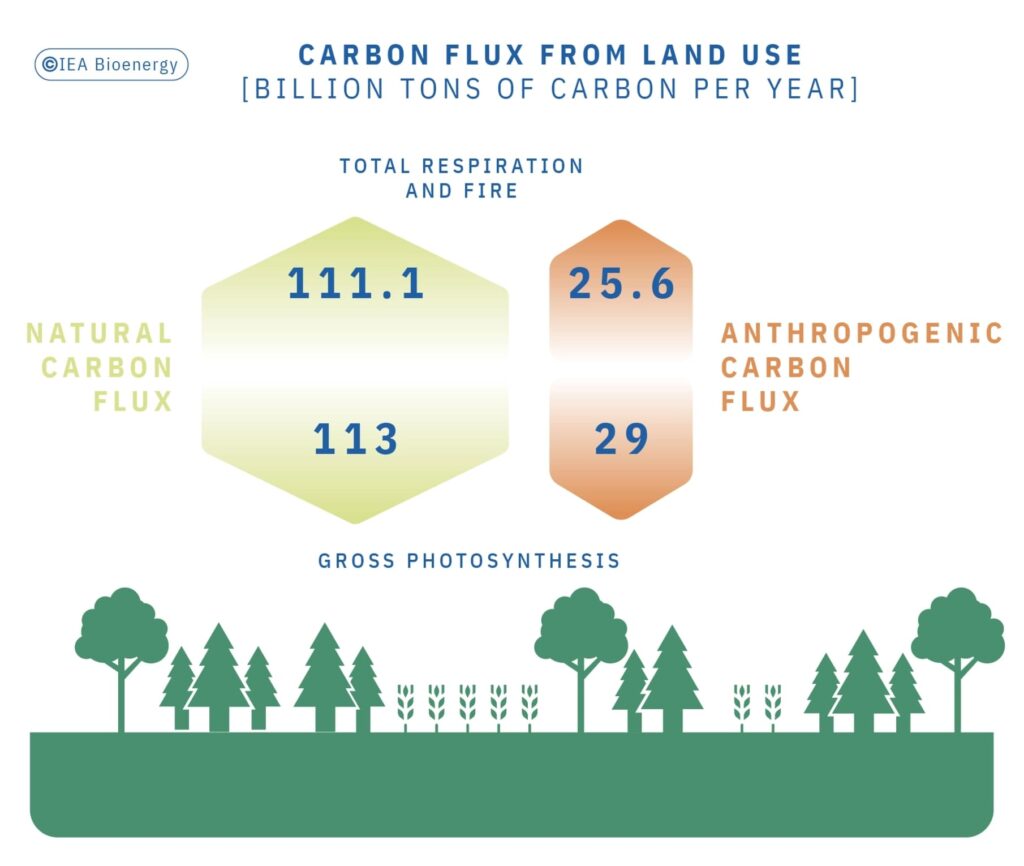
- IEA Bioenergy (2018) Is energy from woody biomass positive for the climate? LINK accessed 20/06/2022
- IEA, Global Energy Review 2021. Greenhouse Gas Emissions from Energy: Overview, Global GHG emissions LINK accessed 18/02/2022
- IEA, Global Energy Review 2021: CO2 Emissions in 2021 LINK
- IEA, Greenhouse Gas Emissions from Energy: Overview, Emissions by sector LINK accessed 18/02/2022
- IEA (2021) Net Zero by 2050 A Roadmap for the Global Energy Sector LINK accessed 18/02/2022
- IRENA (2019), Bioenergy from boreal forests – Swedish approach to sustainable wood use LINK accessed 02/12/2022
- Tripathi N, Hills CD et al. (2019) Biomass waste utilisation in low-carbon products: harnessing a major potential resource npj Climate and Atmospheric Science 2, 35 IEA Bioenergy LINK accessed 18/02/2022
- IEA Bioenergy LINK accessed 18/02/2022
- Göransson L Johnsson F (2018) A comparison of variation management strategies for wind power integration in different electricity system contexts. Wind Energy, 21, 837– 854 LINK
- Cowie A, Berndes G et al. (2021) Applying a science-based systems perspective to dispel misconceptions about climate effects of forest bioenergy. Global Change Biology-Bioenergy. 13,1210–1231 LINK
- Swedish Forest Agency (2021) Sustainable boreal forest management – challenges and opportunities for climate change mitigation LINK
- IEA Bioenergy (2021), Applying a science-based systems perspective to dispel misconceptions about climate effects of forest bioenergy LINK accessed 20/06/2022
- IPCC AR6 WG1. Climate Change 2021: The Physical Science Basis. Full report, chapter 5. LINK
Ensuring biodiversity and the synergies between agriculture and bioenergy

Land management plays a key role in achieving goals related to climate change, biodiversity, desertification, and land degradation and is linked to several Sustainable Development Goals (no poverty, zero hunger, gender equality, clean water and sanitation, affordable and clean energy, responsible consumption and production, climate action, and life on land).
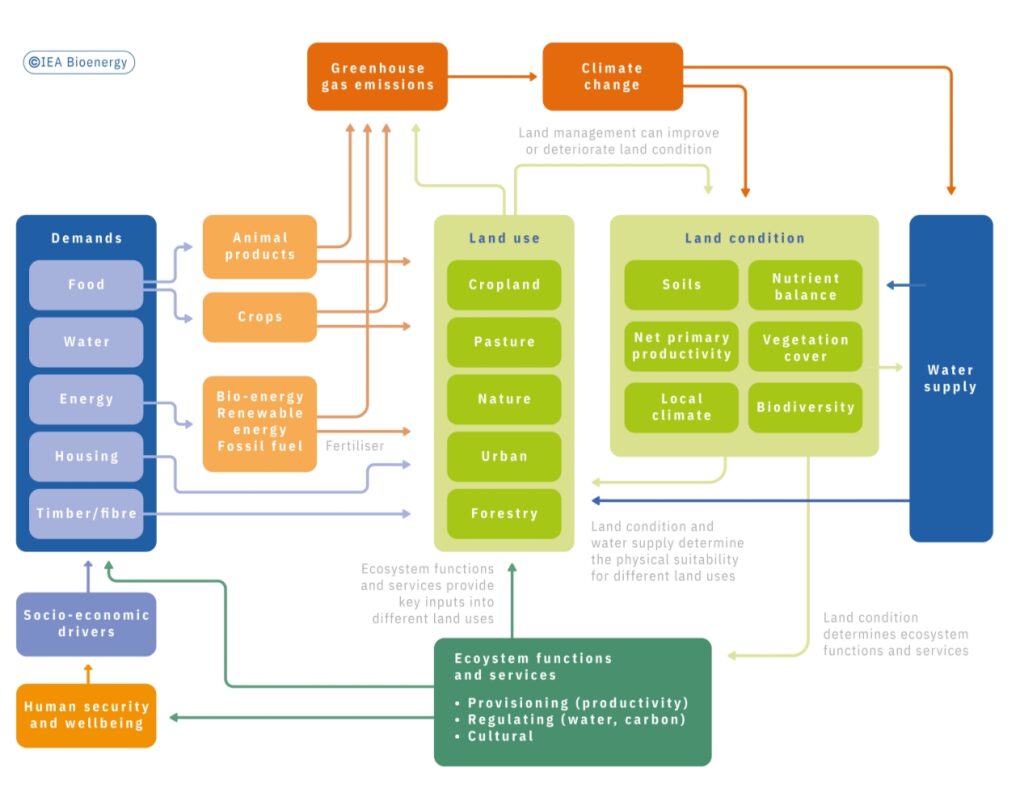
Land Use Change (LUC) and the related effects
- Direct Land Use Change (DLUC) refers to the direct conversion of a specific land area from one use (e.g., forest, agricultural crop cultivation for food/feed) to another (e.g., crop cultivation for biofuels). DLUC can be observed and measured.
- Indirect Land Use Change (ILUC) is an unintended consequence of a land use decision taken elsewhere. Bioenergy production that uses feedstocks grown on arable and pasture land can cause ILUC via market mechanisms; for instance, they can cause increased demand for food and feed, resulting in increased crop prices. This incentivises the conversion of additional land to agricultural use. Converting land with high natural carbon stocks to agricultural use can lead to significant GHG emissions.
The effects of ILUC also need to be accounted for when environmental sustainability is the goal, as they can have a significant negative impact on the GHG balance of bioenergy. To calculate ILUC-related GHG emissions from biofuels, it is vital to analyse the additional biofuel demand and the additional land demand and displacement due to biofuels. ILUC-related GHG emissions are influenced by several parameters, such as, for example, which crops were previously grown on the land and the overall use the land has been put to, the biofuel pathway, technology, the world region in focus, the yield projections, and stakeholder reactions to changing markets. After more than a decade of biofuel growth, actual changes in land use can also be assessed and used to continuously improve modelling.
While it is important to know the magnitude of ILUC effects, the model-based ILUC factors calculated are not fixed values, but depend on market dynamics and local circumstances. Policy is divided on whether to handle ILUC effects using a risk-based approach, for example, to limit crops/farming practices that have potentially high ILUC impacts (EU REDII, Canada CFR (currently under revision), or to add an estimated value for ILUC to the GHG emissions values calculated for biofuels (US RFS2, California LCFS, ICAO CORSIA).
Assessing land availability for biomass potential
The potential of agricultural biomass for energy production largely depends on the available land. Several contextual and science-based methods have been developed to assess the availability of suitable land and related factors for improved land management and sustainable bioenergy production. Examples include Global Agro-Ecological Zoning (GAEZ)—a concept developed by the International Institute for Applied Systems Analysis (IIASA) and the FAO (Food and Agricultural Organization), as well as the FAO Bioenergy and Food Security (BEFS) which fosters sustainable bioenergy while ensuring food security.
This type of methodology makes it possible to identify promising areas for growing biomass for energy based on climate, soil, landform, etc., so as not to interfere with the production of food and feed. High-risk areas in terms of potential damage to ecosystems and biodiversity must be excluded from bioenergy production to ensure biodiversity conservation. Existing agricultural production and infrastructure has to be identified and mapped, and good communication with local stakeholders is critical to confirm data integrity and provide necessary context.
Synergetic development of agriculture and bioenergy
Growing biomass for energy on abandoned, degraded, or marginal lands limits the competition with food and feed. If done in a sustainable way, it restores or improves soil quality and enhances carbon sequestration. However, biomass from abandoned, degraded, or marginal land would be more costly to produce due to increased demand for fertilisers, irrigation, etc. Moreover, the benefits from soil improvement and carbon sequestration would need to be valued economically. A substantial increase in the use of bioenergy crops is thus likely to rely on the use of arable
land.

Biomass for energy may also be produced on good quality agricultural and pasture lands without jeopardising global food and feed supply, as long as agricultural land use efficiency is increased or multi-cropping combinations are implemented. Increased demand in the agricultural sector has encouraged farmers to increase their yields through improved agronomic practices and better seed varieties (e.g., drought- and insect-resistant). The increased demand for crops—partially triggered by biofuels—can positively affect farm income and health and provide income-earning opportunities for women and poor households.
Links between biofuels and food security are complex, and biofuel production can deliver both risks and opportunities. This complexity underlines the importance of the role of sound and science-based assessments, such as FAO ́s Bioenergy and Food Security Approach, or feedstock sustainability certifications. Such assessments will assure the long-term positive impacts of biofuel production and use that do not distort the food and feed markets or negatively affect biodiversity.
Future outlook on land use for bioenergy
According to the IEA Roadmap to Net Zero by 2050, over 60% of global bioenergy supply is projected to come from waste and residue streams, such as agricultural residues or municipal organic waste, thus avoiding the need for dedicated land use. This projection does not, however, fully account for the potential competing uses of residues for bioenergy, fertilisers, animal feed, etc. The remaining 40% of bioenergy supply is projected to be supplied by short- rotation lignocellulosic crops, sustainably managed forests (outside existing forest land), and agroforestry (integrated production of agricultural crops and tree planting). These activities can be implemented on cropland, pasture, or abandoned/marginal lands. No additional arable land is required for bioenergy in this roadmap. Projected land use for bioenergy is estimated to be around 140 million hectares globally; this is below estimated ranges of potential land availability, taking into account sustainability constraints and the Sustainable Development Goals on biodiversity and land use. Nevertheless, certification of bioenergy feedstocks/products and the strict control of additional land use is crucial to avoid land use conflicts and biodiversity losses.
-
PBL Netherlands Environmental Assessment Agency (2017) Exploring future changes in land use and land condition and the impacts on food, water, climate change and biodiversity – Scenarios for the UNCCD Global Land Outlook LINK accessed 18/02/2022
-
European Parliament Directorate-General for Internal Policies, Policy Department A: Economic and Scientific Policy (2011) Indirect Land Use Change and Biofuels LINK accessed 18/02/2022
-
International Institute for Applied Systems Analysis (IAASA) and Food and Agriculture Organization of the United Nations (FAO) GAEZ v3.0 Global Agroecological Zones LINK accessed 20/06/2022
-
FAO, BEFS Assessment LINK accessed 20/06/2022
-
IEA (2021) Net Zero by 2050 A Roadmap for the Global Energy Sector LINK accessed 18/02/2022
FURTHER READING
- Dasgupta P (2021) The Economics of Biodiversity: The Dasgupta Review, London: HM Treasury LINK accessed 20/06/2022
- Englund O, Börjesson P et al. (2020) Beneficial land use change: Strategic expansion of new biomass plantations can reduce environmental impacts from EU agriculture. Global Environmental Change 60: 101990 LINK
- Englund O, Börjesson P et al. (2021) Strategic deployment of riparian buffers and windbreaks in Europe can co-deliver biomass and environmental benefits. Communications Earth & Environment 2: 176 LINK
- Kline KL, Msangi S et al. (2017) Reconciling food security and bioenergy: priorities for action. Global Change Biology Bioenergy 9(3):557-576. LINK
- IEA Bioenergy Task 43 (2019) Attractive Systems for Bioenergy Feedstock Production in Sustainably Managed Landscapes LINK
- Oladosu GA, Kline KL et al. (2021) Structural break and causal analyses of U.S. Corn use for ethanol and other corn market variables. Agriculture 11(3), 267 LINK
- PBL Netherlands Environmental Assessment Agency (2017) Exploring future changes in land use and land condition and the impacts on food, water, climate change and biodiversity – Scenarios for the UNCCD Global Land Outlook LINK accessed 18/02/2022
- Sandstad Næss J, Cavalett, O et al. (2021) The land-energy-water nexus of global bioenergy potentials from abandoned cropland. Nature Sustainability 4,525–536 LINK
- Vera I, Hoefnagels R et al. (2021) Supply potential of lignocellulosic energy crops grown on marginal land and greenhouse gas footprint of advanced biofuels – A spatially explicit assessment under the sustainability criteria of the Renewable Energy Directive Recast. GCB Bioenergy 13(9) 1425-1447 LINK
- Vural Gursel l, Quist-Wessel F et al. (2021) Variable demand as a means to more sustainable biofuels and biobased materials Biofuels, Bioproducts & Biorefining 15, 15–31 LINK
- IEA Bioenergy (2008) The Availability of Biomass Resources for Energy – Summary and Conclusions from the IEA Bioenergy ExCo58 Workshop LINK accessed 18/02/2022
- IRENA, IEA Bioenergy, FAO (2017). Bioenergy for Sustainable Development LINK accessed 18/02/2022
- European Parliament (2011) Indirect Land Use Change and Biofuels LINK accessed 05/07/2022
The water and nutrient footprint of bioenergy

Maintaining soil fertility is important for any cultivation of biomass, regardless of whether the intended use is food, feed, or bioenergy (Photo credit: Pexels/ Greta Hoffman)
Water
The United Nations Environment Programme (UNEP) together with IEA Bioenergy Task 43 produced a joint report on the bioenergy and water nexus in 2011; this report considered bioenergy and water to be inextricably linked. In other words, water availability affects the availability of sustainable bioenergy. As bioenergy is largely dependent on biomass production (as dedicated energy crop, or as residue of other agricultural or forest products), expected growth trends will lead to increasing competition for, and pressures on, water resources. These pressures may be attenuated if the sustainability criteria for bioenergy production, advances in technology, and the use of different feedstocks are adhered to.
Water demand, bioenergy water footprint, and related policies
Water use occurs throughout the bioenergy production cycle, including feedstock production and conversion. Quantifying the impacts of bioenergy production on water resources is, however, complicated because of the feedstock diversity and the fact that biomass production happens concurrently for multiple applications (food, feed, materials, energy). Variability in site-specific conditions and the conversion processes also have a role to play. Particularly for policymaking, this large number of influencing factors requires an understanding of the advantages and limitations of each factor and their impact on bioenergy production and related water demand. Inventories provide values for the “water efficiency” of different bioenergy pathways.
A recent study reports large differences among the water footprints of the different feedstocks used for bioenergy, and also the technologies (i.e., chemical, biochemical, thermochemical technologies), as well as the consequences of applying these in future energy mixes. The report shows that residues are the most favourable bioenergy feedstocks in terms of water use. The total water footprint does not increase when residues are applied for energy purposes. When crops are grown primarily for energy, however, the water footprints are clearly larger, and this should be particularly taken into account in regard to river basins with increasing water scarcity.
To avoid a negative impact of bioenergy production on the water balance, targeted policy instruments are needed to address the water implications of bioenergy production. They should be designed to help avoid long-term adverse consequences while maximising potential benefits (e.g., new rural jobs and new options for sustainable land and water use). Bioenergy-related water policy instruments need to be designed for coherency with instruments in related policy sectors and with existing water policy instruments, including those concerned with irrigation and other agricultural practices and industrial water use. Such policies can include incentives for enhanced soil moisture conservation measures, including rainfall capture, conservation tillage, and precision agriculture.
Recommendations for implementing and ensuring a sustainable bioenergy–water nexus
In 2016, the Global Bioenergy Partnership (GBEP) and IEA Bioenergy joined forces to collect information and carry out analysis on “Positive Bioenergy and Water Relationships”. Inter alia, the following key messages for positive examples that could well work as role models for various locations and regions were identified:
- Consider location-dependent conditions, when applying integrated water planning and management;
- Design and implement effective water-related policy instruments that address the impacts of biomass and bioenergy production on water availability and quality, and at the same time carry out effective monitoring of the competition between sectoral uses of water;
- Disseminate best management practices and support capacity building among farmers and
NGOs in the field; - Consider a comprehensive socio-ecological perspective, including ecological functions in
agricultural and natural landscapes and broader livelihood and development implications; promote sustainable land and water use.
- Take a holistic approach at the appropriate geographic level and consider a long-term perspective through application of integrated water planning and management at the watershed level: namely, consider location-dependent conditions; apply life cycle perspectives; and account for potentially synergistic effects (e.g., for food and fuel production, irrigation, etc.);
- Base decisions on scientific impact assessments to ensure sustainable water management by considering a comprehensive socio-ecological perspective, including ecological functions in agricultural and natural landscapes and the broader livelihood and development implications;
- Design and implement effective water-related policy instruments that address the impacts of bioenergy production on water availability and quality; carry out effective monitoring of the competition between sectoral uses of water.
- Establish/support appropriate institutions and processes, including inter-ministerial task forces; ensure stakeholder engagement from the planning through the implementation phases;
- Disseminate best practices and promote new technology through upgrading of extension services and promotion of special training through certification schemes.
- Intensify dialogue on the topic of the bioenergy-water nexus and on capacity building, inter alia, with groups and organisations working on the issue; build the capacity of the different groups in emerging economies and developing countries to include decision makers.
- Conduct further research, fill data gaps, and develop regionalised tools, for example, by supporting international cooperation in research into the impacts of bioenergy development on water, as well as by further developing regionalised tools, given that life cycle impact assessments (LCIA) and water footprint (WF) are inadequate without the differentiation of localised impacts.
Bioenergy and soil nutrients
The bioeconomy—which includes bioenergy—relies on a continuous supply of biomass. The soil conditions especially play an important role in the production of this biomass. Biomass not only contains carbohydrates but also nutrients. Some of these nutrients will be extracted from the soil during biomass production and harvesting, and some will be lost during the further processing of the biomass. The soil needs to be kept in good condition to maintain sufficient biomass production. Some of the nutrients that are harvested with the biomass can be retained within the residues for bioenergy production. These residues from bioenergy production (e.g., digestate, compost, biochar) can be fed back to the soil as a fertiliser by-product.
The growth and removal of biomass from soils has impacts both on the soil organic matter content and on the nutrient balance. The more biomass harvested, the less biomass is available to return to the soil to maintain soil organic matter levels. Scientists explain that the utilisation of residues from bioenergy production, like digestate or biochar, can help to maintain soil organic content, while the use of cropping residues for bioenergy reduces the return of organic material to the soil.
The Water–Energy–Nutrients Nexus
A recent research study explains that water, energy, and nutrients are the main pillars in the design of a circular economy-based agricultural system. There are various correlations and links between these pillars, and these create technological bases for sustainable economic and social development.
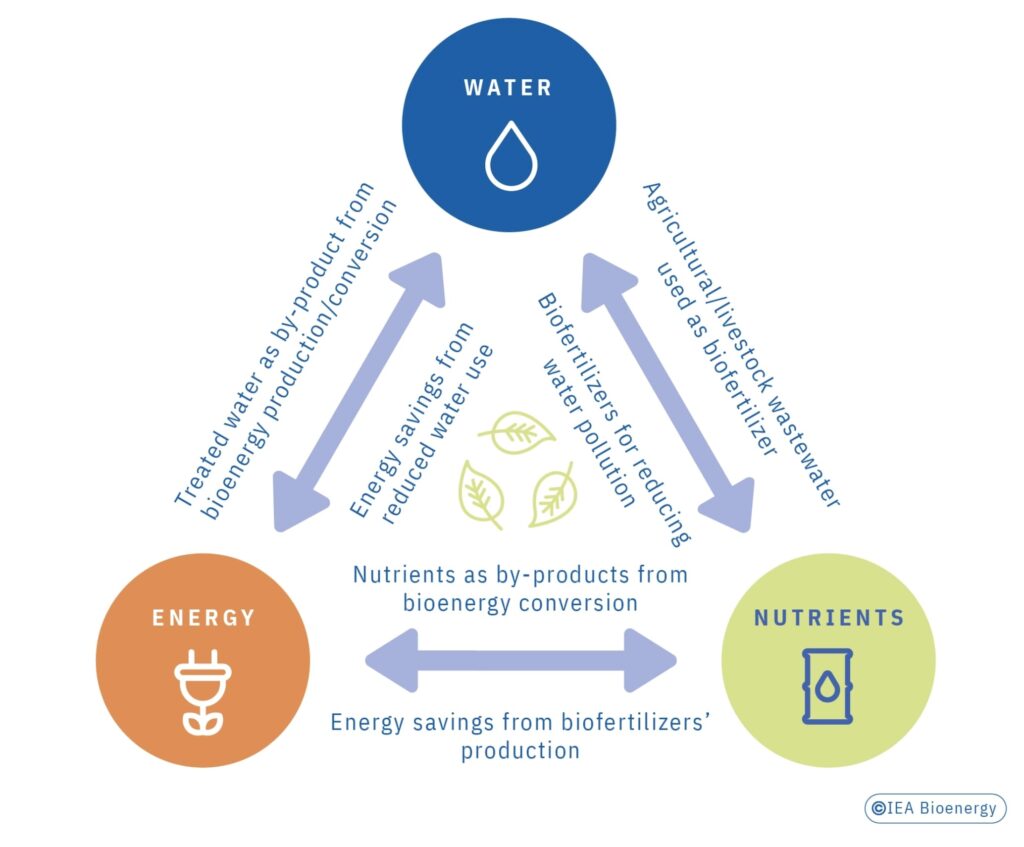
In contrast, fertilisation using synthetic fertilisers is among the most energy- and cost- consuming field operations, as well as having an adverse environmental impact. According to the research study, this is the key reason for so much attention being devoted to nutrient circularity applications and avoidance of the use of synthetic fertilisers as much as possible.
Sustainable nutrient management for biomass production and bioenergy
A comparative study in the United States shows that without soil amendments, typical row crop agriculture such as maize results in a net removal of nutrients and carbon from the soil. A harvest in one location removes plant material rich in nutrients for consumption by animals or humans in another. This annual removal of nutrients can be compensated for by fertiliser application. Manufacturing of synthetic fertilisers and application to row crops, however, has several adverse environmental consequences. Production of fertiliser is energy-intensive, and its production and use contribute significantly to CO2/N2O emissions and nitrate leaching.
Nitrate leaching under developing perennial grasses drops dramatically and perennial grasses (miscanthus, switchgrass, etc.) have the potential to build soil carbon and nitrogen pools, providing additional ecological benefits in addition to displacing fossil fuels.
There is also growing evidence to suggest that perennialisation on degraded lands has a large potential for restoration, particularly as additional ecosystem services can be provided simultaneously. Sustainable biomass production systems based on perennial plants can simultaneously deliver climate mitigation (lignocellulosic biomass replacing fossil resources), animal production (intensive rotational grazing), and biodiversity conservation (natural ecological succession). Perennialisation has substantial promise for restoring fertility to degraded croplands, thus helping to meet future food security needs.
Example of a modern tool to optimise soil nutrients in bioenergy systems
Dutch scientists have developed the BioESoil tool to assess the impacts of bioenergy on soil quality. The tool can help users, including bioenergy producers and certification organisations, to determine the impact of bio-energy production on soil fertility and soil organic matter. It can also help NGOs and other organisations to create awareness of nutrient recovery options in bio-energy production and use.
- United Nations Environment Programme (UNEP), Oeko-Institut and IEA Bioenergy Task 43 (2011) The bioenergy and water nexus LINK
- Gerbens-Leenes PW (2018) Green, Blue and Grey Bioenergy Water Footprints, a Comparison of Feedstocks for Bioenergy Supply in 2040, Environmental Processes 5, 167–180 LINK
- Global Bioenergy Partnership and IEA Bioenergy Report Examples of Positive Bioenergy and Water Relationships (2016) LINK
- Wageningen University & Research, BioESoil LINK accessed 20/06/2022
- Rodias E, Eirini Aivazidou E et al. (2021) Water-Energy-Nutrients Synergies in the Agrifood Sector: A Circular Economy Framework, Energies, 14(1), 159 LINK
- Masters MD, Black CK et al. (2016) Soil nutrient removal by four potential bioenergy crops: Zea mays, Panicum virgatum, MiscanthusÅ~giganteus, and prairie, Agriculture, Ecosystems & Environment (216) 51-60 LINK
- Mosier S, Córdova SC at al. (2021) Restoring Soil Fertility on Degraded Lands to Meet Food, Fuel, and Climate Security Needs via Perennialization, Frontiers in Sustainable Food System, 11 LINK
Bioenergy as a driver for certification and conservation

Bioenergy as an integral part and potential driver of a sustainable land use for people and nature (Photo credit: Unsplash/Moritz Kindler)
Bioenergy can be a powerful driver for sustainable land use and biodiversity conservation; this is shown by a series of recent studies on the potential of biomass for bioenergy that specifically consider environmental sustainability criteria and high biodiversity areas. Thoughtfully produced biomass need not have a damaging impact on biodiversity and sustainability goals.
Positive examples of certification systems, labels, and schemes are, inter alia, RSB (on bioeconomy), ISCC (sustainable feedstocks), SBP (forest biomass), the Bonsucro initiative on sustainable sugarcane production, and the efforts of the Roundtable on Sustainable Palm Oil (RSPO) for the certification of sustainable palm oil production. The latter two were initiated because of concerns over the sustainability of transport biofuels produced from these resources, but the schemes are also having a positive impact on food production.
If such restrictions and considerations of biodiversity protection are not followed, biomass production could have a negative impact on biodiversity and sustainable land use. In the case of the EU, risks associated with biomass trade are addressed by requiring that bioenergy and bioenergy feedstocks used in the EU comply with the mandatory sustainability criteria in the RED/RED II in order to benefit from public financial support and to count toward the overall renewable energy targets—irrespective of geographic origin. Compliance can be proved through either national or EU-wide recognised voluntary certification schemes.

In the sustainable land management context, restrictions with respect to biodiversity and sustainability criteria seem to be particularly important for biomass production from grasslands, which are considered highly biodiverse. Experts caution to rely only on the approach of identifying high biodiversity areas (must be protected) and land that is marked as “available” for sustainable biomass/bioenergy feedstock production. This is because the correct designation for bioenergy production might be difficult to characterise.
Moreover, indirect land use effects could have negative impacts on neighbouring plots or even across countries and continents. When it comes to sustainable bioenergy feedstock production, science recommends a combination of safeguards—top-down (including global biodiversity programs) and bottom-up (including national and/or subnational lists of plant habitat types)—to ensure compliance with the strict land use policies in place combined with clear sustainability criteria and indicators (e.g., through recognised certification systems).
Carefully developed and science-based sustainability policies could lead to (a demand for) bioenergy to become a positive driver for the introduction of improved sustainability criteria for biomass production, sensible land use policies, and biodiversity protection; this is particularly so considering the importance of bioenergy for climate change mitigation. In such cases, bioenergy would become a positive driver for a transition towards sustainable land use, with the achievement of biodiversity being a top priority.
Certainly, the actual influence of bioenergy production on sustainable land use and biodiversity protection, and vice versa, will depend on the real-world implementation of the relevant regulations, and these will vary by region. In this regard, scientists recommend a learning- by-doing approach to identify the merits and pitfalls of biomass deployment and to improve understanding of the prospects for achieving higher levels of sustainable biomass production for bioenergy.
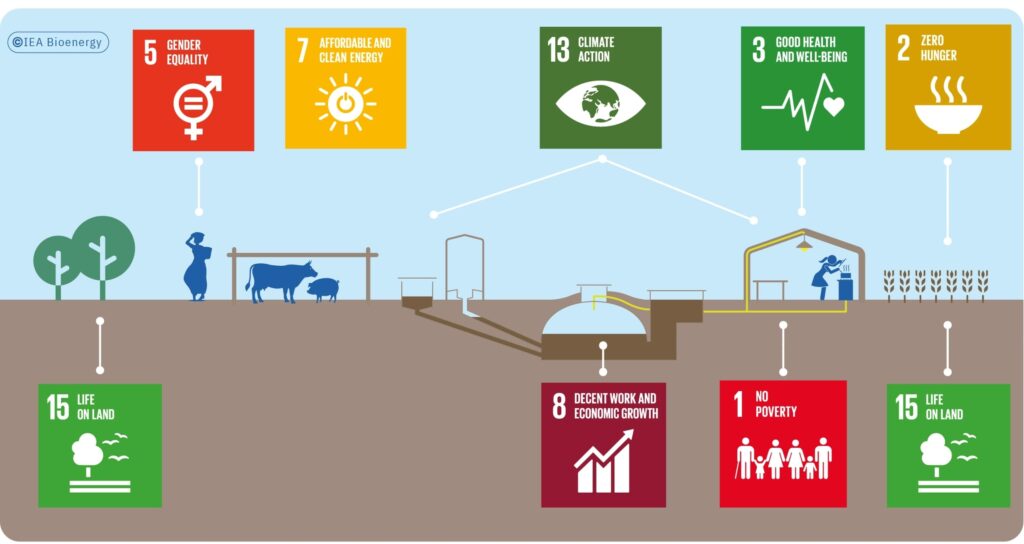
Scientists and industry experts behind IEA Bioenergy documented and analysed a total of 37 case studies from every continent with a range of feedstocks, supply chains, and end uses; their aim was to learn if and how biomass supply chains contribute to sustainable development (see also chapter 4: Social sustainability and the need for a just transition).
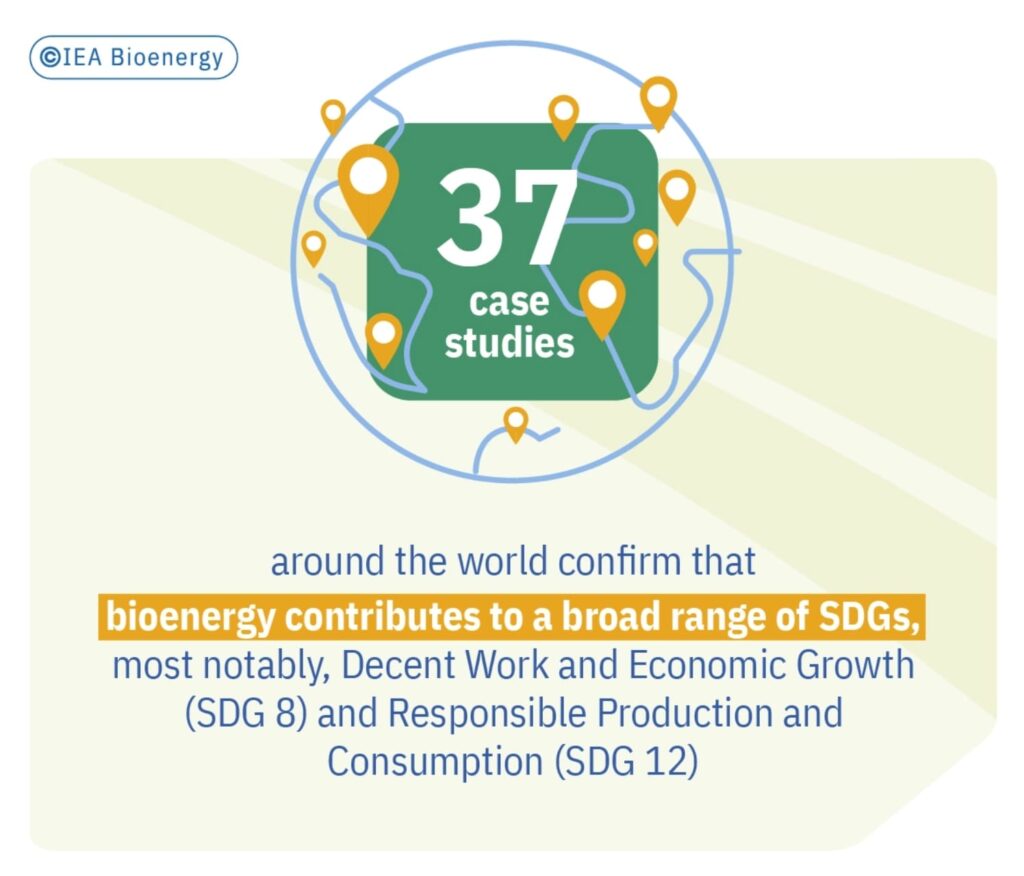
For example, while agricultural supply chains (i.e., energy crops and residues) are more likely to positively impact Zero Hunger (SDG 2) and Clean Water and Sanitation (SDG 6), waste and forest supply chains are more likely to positively impact Life on Land (SDG 15). Biomass supply for bioenergy generation was also found to indirectly contribute towards socio-economic development such as No Poverty (SDG 1), Quality Education (SDG 4), Gender Inequality (SDG 5), and Reduced Inequalities (SDG 10). At least half of the 37 case studies reviewed contributed towards Decent Work and Economic Growth (SDG 8), Industry, Innovation, and Infrastructure (SDG 9), and Responsible Production and Consumption (SDG 12), with differences in contributions across supply chains.
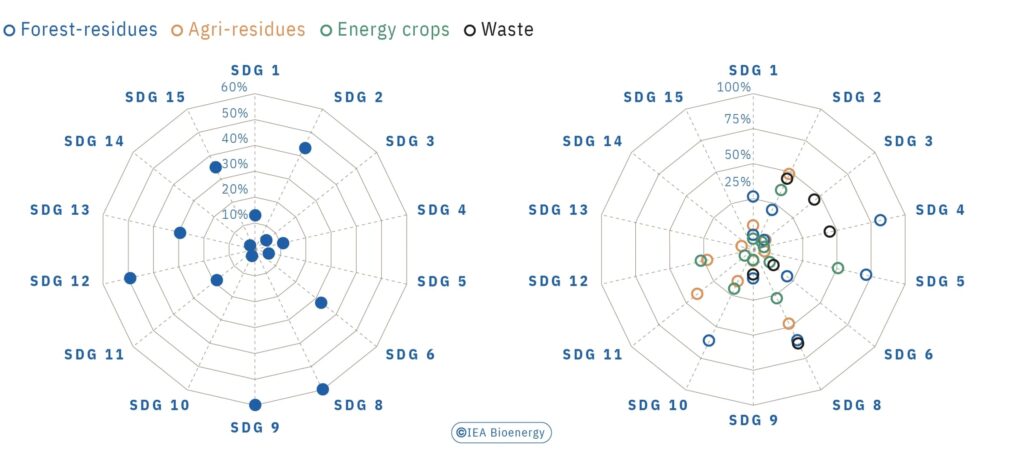
- Kluts I, Wicke B et al. (2017). Sustainability constraints in determining European bioenergy potential: A review of existing studies and steps forward. Renewable and Sustainable Energy Reviews, 69, 719–734. LINK
- Roundtable on Sustainable Biomass (RSB) LINK accessed 20/06/2022
- International Sustainability & Carbon certification (ISCC) LINK accessed 20/06/2022
- Sustainable Biomass Program (SBP), LINK accessed 20/06/2022
- BonSucro, Global sustainability platform for sugarcane LINK accessed 20/06/2022
- Roundtable on Sustainable Palm Oil (RSPO) LINK accessed 20/06/2022
- Hansson J, Berndes G et al. (2019) How is biodiversity protection influencing the potential for bioenergy feedstock production on grasslands? GCB Bioenergy 11,517–538 LINK
- Hennenberg KJ, Fritsche UR et al. (2009) Practical Implementation of BioSt- NachV – Sub-project Area related Requirements (Art. 4–7 + 10) – Specifications and recommendations for “grassland” area type (Final draft) LINK accessed 18/02/2022
- Slade R, Bauen A et al. (2014) Global bioenergy resources. Nature Climate Change, 4, 99–105. LINK
- Blair MJ, Gagnon B et al. (2021) Contribution of Biomass Supply Chains for Bioenergy to Sustainable Development Goals. Land, 10, 181 LINK
